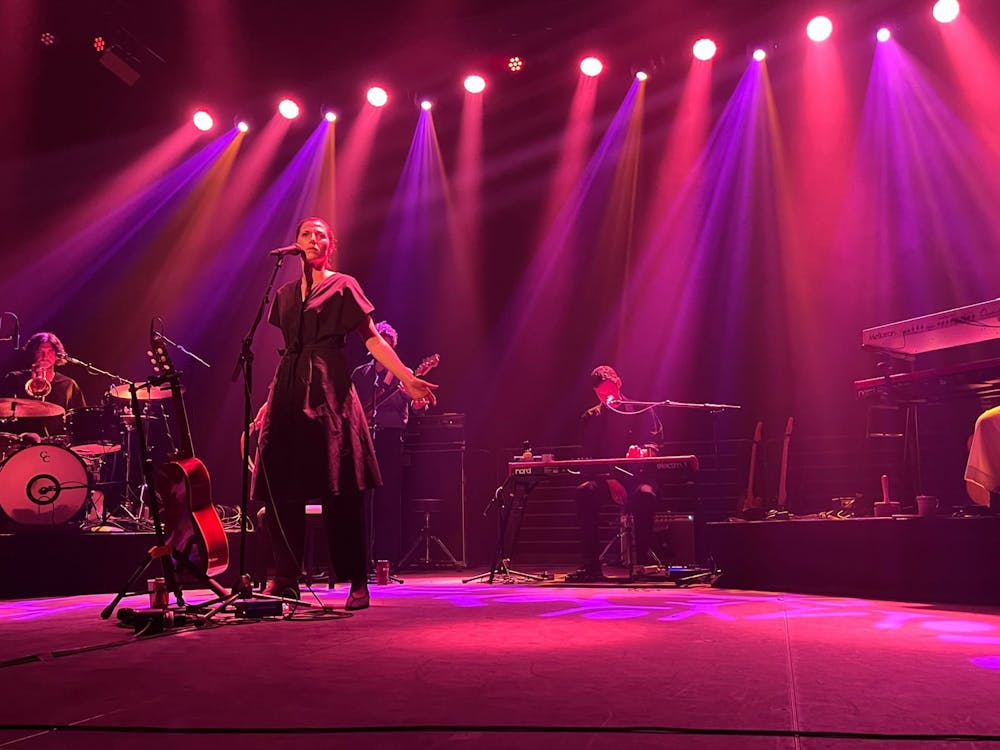Sophia the Robot, Robert Zemeckis’ The Polar Express, and Aldous Harding can all make you feel discomfort. But—barring any technofuturists or early–aughts CGI fanatics—only one has the power to make you feel something beautiful.
The former two are classic examples of the “uncanny valley,” a feeling of unease that’s evoked when something looks almost–human, but not human enough. Most of the time, the face is the dead giveaway. People can sort genuine emotions from disingenuous ones remarkably well, so if a robot takes even a second too long to smile, it sets off alarm bells somewhere deep in our psyche.
Watching Aldous Harding perform makes you uncomfortable in the exact opposite way: Her expressions are too genuine. She grimaces like she just stubbed her toe and twists her countenance into a gargoyle–like visage, the kind of face you might make at yourself alone in the mirror. She dances like someone who’d give anything to disappear at their school dance. And when she affixes you with her unblinking gaze, it’s as if she’s staring right past whatever façade you’ve put up, too.

Still, these qualities commanded the stage last Friday at Union Transfer, where Harding ran through the entirety of her new record Warm Chris, plus selections from 2019’s Designer and 2017’s Party. For Harding (the Kiwi singer–songwriter also known as Hannah Sian Topp), performing these songs live imbued them with an unprecedented emotionality for an artist often classified as cryptic or oblique. Out of the three opening numbers, “Ennui” found Harding playing at being disgusted by the audience. “Tick Tock” was eerie and spaced out, and “Fever” burned with anger and impassioned yearning in equal parts.
I’d be remiss not to mention the evening’s opener (and member of Harding’s band!) H. Hawkline, since he perfectly set the tone for the show. After some light back–and–forth with the audience, since, in his words, this would be his last chance to establish any chemistry with us, he pulled an ingenious trick ripped straight from the playbook of Talking Heads’ concert film Stop Making Sense: He reached over to the reel–to–reel tape player that looked more like a face the longer you stared at it, and pressed play.
The backing track began with the even clip of a drum machine, and pretty soon a whole band bloomed to life from the speakers. That tape player kept going nonstop for Hawkeye’s whole set as he ran through a series of new wave–y guitar pop songs that put his swooping, supple falsetto front and center, channeling The Smiths, Mac DeMarco, and Harding herself. Many of the tracks he played haven’t been released on streaming yet, but of those that have, highlights were “Engineers,” which featured some angular guitar interplay reminiscent of his ex–girlfriend Cate Le Bon, and “Last Thing on Your Mind,” mainly for the David Byrne–esque dance performance that accompanied it.
For her part, Harding wasn’t much for banter with the crowd. When a woman in the audience noted that she had switched from her signature Red Bull to sips of Coke between songs, she awkwardly acknowledged it, pulling back her lips for the audience to reveal a couple teeth missing from the back of her mouth.
This was all par for the course. Earlier on, in response to shouts of “Thank you!” and “I love you!” she replied, classically measured, “People always want me to say things, and when I do, they don’t know what to say.” She took a few seconds to tune her guitar and then added, flashing the audience a mischievous grin, “So let’s not do that anymore, eh?” It felt like a test, daring us to ask how much of this was performance and how much was vulnerability.
More uncanny still were Harding’s stilted and tentative movements, especially how they contrasted with her dexterous and certain voice. From “Warm Chris,” a hushed ballad where she dipped into a smoky alto, to the cartoonish vocal contortions of “Leathery Whip,” Harding displayed the full breadth of her talents as a singer. Instrumentally, she showed off her deft fingerpicking and arsenal of percussion—including tambourine and cup with drumstick. Even on the purely acoustic numbers, her foot was always keeping perfect tempo.
Thanks to a tight band and brawny rhythm section, the night’s more upbeat songs, like “Lawn” and “The Barrel,” were almost danceable—or at least head–boppable and toe–tappable. But you know it’s a truly special show when even the quieter moments keep the audience hushed and transfixed.
Ballads “Staring at the Henry Moore,” “Bubbles,” and “She’ll Be Coming Round the Mountain” left the crowd in a near–trance—without the need for any fancy lighting rights or fog machines. And when Harding launched into the opening chords of the sparse “Treasure”—a song that will break your heart, even though you can’t put your finger on why—I heard a guy behind me mutter, “Oh my god, I’m gonna cry.”
Even though Aldous Harding lamented, “I’m a much better songwriter than I am at building friendships,” I hope she grasps the emotional weight that her songs hold for a lot of people.
And I think she does. That connection was palpable when she took a courteous bow and thanked the audience for coming. Maybe it transcended the disconcerting theatrics, or maybe it was amplified by them. Either way, it has to be seen to be believed.







